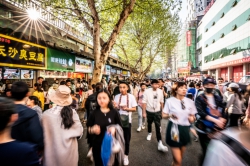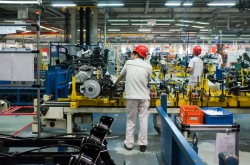Role of high-performance computing in modern science
High-performance computations make it possible to model events or phenomena with a large number of participants and objects influenced by multiple external factors that can be hard to assess or predict without using additional means. For instance, forming and movement of crowds, evacuation, spread of disease, or weather conditions. Modeling such phenomena helps forecast their development under different circumstances. For one, scientists recently created a model of crowd movement at the Kumbh Mela festival and used it to forecast how the crowd’s dynamics will change when it encounters obstacles. Various models can be used for developing decision support systems, for example, in the medical field such algorithms can be used for dispatching ambulance cars.
ICCS conference
The International Conference on Computational Science (ICCS) brings together scientists in the field of computer technologies who use high-performance computations in such areas as physics, chemistry, engineering, life sciences, as well as arts and humanities. The conference’s minutes help the scientific community identify the relevant topics in the field of high-performance computations. For one, the 2018’s conference topic was “Science at the Intersection of Data, Modelling and Computation”, and the next year’s topic will be “Computational Science in the Interconnected World”.

World-renowned scientists are invited as keynote speakers for ICCS: this year, among them were professor Petros Koumoutsakos from ETH Zürich, researcher Tomaso Poggio from the MIT, Liesbet Geris from the University of Liège, and others. As Denis Nasonov, head of the BigData and Extreme Computing Master’s program notes, all the reports presented at the conference undergo a rigorous selection process. At the conference, he took part in the section that focused on infrastructures and presented his a report on developing a new Data Marketplace platform and reliable transaction control.
Conference’s relevant topics
“Much as last year, many reports had to do with the tasks of artificial intelligence and machine learning. For instance, they presented the new RT-DBSCAN algorithm (based on the popular DBSCAN) that works in real-time mode, which is most relevant in regards to the modern tendencies of stream-oriented processing. At the section I headed, there were also reports on optimization in using modern supercomputer architectures, including ones such as Sunway TaihuLight and Summit. On the whole, we established many new contacts at the conference, including those with people from CERN and the Nanyang Technological University, as well as got acquainted with Chinese culture and their scientific schools,” comments Denis Nasonov.

Over the recent years, the topics that have been becoming all the more popular in the field of Big Data-related research are the improvement of technologies of primary data collection and processing and the emergence of new digital mechanisms like IoT and social networks that can be used for registering unobservable processes. Specialists in such fields will be sought after by not just modern IT companies, but also hi-tech enterprises whose activities are based on digital processes.
“The ICCS conference highlights the main trends in the field of computer technologies and their application in research. It’s worth mentioning that this is an initiative of the participating scientists, not the conference’s organizers. This happened when accessible GPGPU technologies emerged, as well as during the advance of IPv6 based network technologies. Nowadays, machine learning and intelligent technologies are a hot topic. Many of our colleagues stressed the increasing interest in these topics in their reports in different sections,” says Sergey Kovalchuk, head of the Computational Biomedicine Master’s program.
ITMO’s research in computational biomedicine was presented by two projects. The first was included into the conference’s first section; it focused on combining imitation and game-theoretic modeling for developing approaches to controlling decentralized decision making in city environment on the example of dispatching ambulances providing service for ACS patients. The second one focused on machine learning-based text mining in electronic health records. These two topics get much attention at the university, and many researchers and students, especially from the Computational Biomedicine program, participate in such research.

What’s more, since 2012, ITMO’s eScience Research Institute has been conducting a workshop on urgent computations at ICCS. There, specialists discuss modern methods and computational instruments for creating decision support systems for emergency situations: the necessary software, platforms and infrastructure, the methods for visualizing a model, the use of VR and the development of mobile applications.
Getting to know Chinese culture
Every year, ICCS takes place at a different location, so its participants can experience the culture of different countries. We asked ITMO’s young scientists who participated in the conference about their impressions of Wuxi.
Ivan Derevitskii, engineer at the eScience Research Institute
“Shanghai met us with smog, and the locals’ inability to speak any English, as well as food stalls and gaudy signboards on the narrow streets of the Old City. After we moved in a luxurious hotel in Wuxi, we sucked in knowledge at the conference’s many sections, and enjoyed the local cuisine and communication with colleagues from all over the world during the breaks. My report on an agent based model for opinion dynamics prompted several questions from colleagues at the agent-based modeling section, which I properly answered. China left many memories. On the streets, you feel like a movie star: people photograph you, openly or discreetly, touch you, leave their stalls to show you the way or call a taxi. They really like Europeans.”

Oksana Severiukhina, engineer at the eScience Research Institute
“Our trip was full of adventures. Already in an airport in Moscow, we found ourselves in a crowd of Chinese who fought with suitcases in order to get on the plane. From the Chinese airport, we went to Shanghai by maglev, a magnet train that covers 30 kilometers in some seven minutes. The lag time made every morning difficult. The conference lasted for three days, and featured lectures, workshops, and a poster session. My report was on the last day, which, I believe, was the hardest thing for me, as you can really feel relieved and enjoy the event only after you’ve done your part. During our free time, we’ve had a chance to see the biggest bronze Buddha statue, admire the rain coming from the ceiling of a Chinese theatre, lessons of street dancing, Chinese palaces and skyscrapers, golden fish in the royal pond and the mountains of rented bikes piled up in the streets.”





